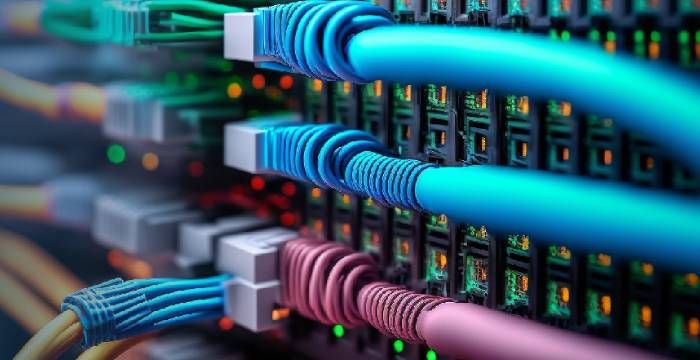The right Ethernet cable type can improve your internet performance and speed. Ethernet cables, especially manufactured by Monk Cables offer a faster and more reliable internet connection as compared to wireless network (Wi-Fi). These cables are ideal for video streaming, online gaming, and working remotely.
Choosing the best Ethernet cable among so many types might be challenging, since each works differently in terms of reliability and performance. So keep reading to learn more about these types and which suits you best.
Understanding Ethernet Cable Categories

Ethernet cable is categorized based on the quality of its performance, mostly in terms of bandwidth and speed. Usually, the cable having a greater category number is best in terms of quality and performance. Let's discuss the most common types of cables and for which use they are best suited.
Cat 5e (Category 5e)
A newer version of the previous Cat 5 standard, Cat 5e cables have a bandwidth of 350 MHz. They have the capacity to accommodate speeds of 1 Gbps with a maximum of 100 meters. For simple home internet connections, these cables are affordable and in demand. A Cat 5e cable would be sufficient if you currently have a 1 Gbps internet connection and do not intend to upgrade it in the foreseeable future. But it is interesting that this standard is already being outdone by new standards because faster internet speeds are now becoming more common.
Cat 6 Ethernet Cable
With a maximum 500 MHz frequency, Cat 6 cables can support up to 10 Gbps speed over a short distance (up to 55 meters). Due to shielding, they experience reduced overall interference and crosstalk and are a higher upgrade level than Cat 5e. For those with internet plans from 1 to 2.5 Gbps, Cat 6 is ideal. They're also more future-proof and a worthwhile investment if you're replacing your home network.
Cat 6a (Augmented Category 6)
Augmented Category 6 cable (simply known as Cat6 cable) has the ability to support bandwidth of 650 MHz and carries data at a rate of 10 Gbps over 100 meters. They work well for longer cable runs. or applications in locations where electrical noise is higher. They are more shielded than Cat 6 and have lower signal interference. Cat 6a would be a better option if you are creating a home office or want a cable that will later be capable of fulfilling higher performance requirements.
Cat 7 Ethernet Cable
With a maximum bandwidth of 750 MHz, cat 7 cables can drive rates of up to 10 Gbps over 100 meters. They support high-interference applications and offer better shielding than Cat 6a. Cat 7 cables aren't used in home networks very often because they're not very flexible and Cat 6a and Cat 8 cables are easier to find.
Cat 7a (Augmented Category 7)
Capable of a top speed of 10 Gbps over 100 meters, Cat 7a offers incremental advantages over Cat 7 like having bandwidth up to 1000 MHz.. It targets enterprise-class and specialized industrial environments. Like Cat 7, it is compatible with typical home networking gear only since it employs the GG45 connector. Its relatively high cost and poor backward compatibility makes it impractical to use for most residential customers.
Cat 8 Ethernet Cable
Cat8 is a potent Ethernet cable, now available to purchase for consumers. They have a massive bandwidth of 2000 MHz and can support incredibly high-speeds of as much as 40 Gbps. Even though they support such high speeds, they can only be stretched to a maximum effective distance of approximately 30 meters. Cat 8 is commonly applied in high-performance computing systems and data centers. This amount of capability is not necessary for most home consumers, and is likely overkill in both cost and functionality.
Recommendations Based on Your Needs
Cat 6 cables represent the ideal price, speed, and reliability for most residences. They are affordable, gigabit-speed wired, and possess sufficient bandwidth to support everyday internet activities such as streaming, gaming, and video calling.
Cat 6a is your best option if you work from home, have an above-1 Gbps internet subscription, or prefer to future-proof your system. For heavy loads, it delivers stable speed, improved shielding, and longer range performance.
Only if you have a top-of-the-line server setup or require very fast transfer rates over very small distances should you consider Cat 8. For regular use, it is not worth the extra cost and hassle.
Key Considerations to Choose Fast Ethernet Cable
Although it is necessary to know about types of Ethernet cables, there are a few more things to keep in mind while selecting fast Ethernet cables.
Assess the Required Length
Keep your required length in mind when selecting an Ethernet cable. From 3 feet to more than 300 feet long, Ethernet cables are available. Find out how far away your device is from the router and add some extra length, if the cable has to go through ceilings, baseboards, or walls. The longer the cable, the more critical it is to pick one with more performance and shielding so that signal loss does not occur.
Opt For Pure Copper Cable
Always opt to purchase a pure copper cable, since there is a trademark with the wording TIA 568-C.2 or “pure copper wire’’ is marked on the packaging. These are more of high-quality performance and reliability.
Also, keep in mind the environment where you are going to install the cable. Go for the shielded cable for the areas with the higher electromagnetic interference. STP shielded cables are far more effective at eliminating interference and crosstalk.
Understand Cable Durability
The majority of the cables have a shelf life of 5 to 10 years based on the jacket material used.
- Plenum-rated cables are made with low-smoke, fire-retardant materials and hence are the longest lasting.
- PVCs cost less, but they have a shorter lifespan.
Match the Cable with Your Internet Speed
Your internet plan's speed should be compatible with your Ethernet cable.
- 100 MHz and 1 Gbps are the highest speeds for Cat 5 and Cat 5e.
- Choose Cat 6a, Cat 7, or Cat 8 for high-speed (10+ Gbps) because these support high bandwidths and will future-proof your network.
While home users focus on choosing the right cable for their setup, tech giants are scaling internet speed from a global lens — not just through cables above ground but even underwater. Companies like Meta and Google are investing in deep-sea cable systems that will power the next generation of ultra-fast connectivity. Read how they’re building the future of the internet underwater to understand how infrastructure is evolving far beyond home networking.
Conclusion
You can make your internet speed fast by choosing a reliable Ethernet cable. Cat 6 or Cat 6a cables might be a suitable choice for most users. These cables offer quick speeds, reliability, and future-proofing. While Cat 7 and 7a work well, they are not typically compatible and don't greatly exceed Cat 6a for a straightforward home network.
Cat 8 is probably not required unless you are building a server room or your data needs are extremely high. Knowing the variations between Ethernet types will allow you to make an informed decision to maintain your internet speedy and stable.
Post Comment
Be the first to post comment!





